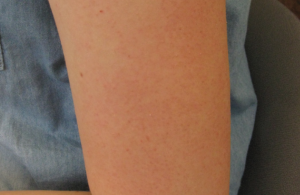Chapter 15: Other Dermatologic Conditions
Scars: Keratosis Pilaris
What is it?
Keratosis pilaris (KP) is a common condition to due keratin plugging of hair follicles. It runs in families as an autosomal dominant trait. KP is most prominent during childhood and teenage years and usually spontaneously resolves by adulthood.
What does it look like?
Patients have tiny rough, red bumps in a follicular distribution, most commonly over the posterior upper arms and lateral thighs. Variants include: keratosis pilaris rubra facei that has rough bumps on a background of erythema; ulerythema ophryogenes associated with loss of lateral eyebrows, and keratosis pilaris atrophicans that leaves pitted scars. In patients with darker skin of colour there can be hyperpigmentation at each hair follicle. KP is generally asymptomatic but some patients experience itch.
How is it treated?
There is no cure for keratosis pilaris since it is a genetic trait. However, as mentioned above it does improve with age. Treatment with emollients is helpful, especially those with a keratolytic, such as salicylic acid or urea. Any treatment however is a temporary fix as the bumps do reappear after moisturization is stopped. If itch is a concern, then a mild topical corticosteroid is usually sufficient.


